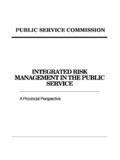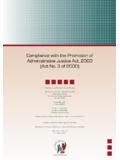Transcription of Toolkit for the Management of Poor Performance in the ...
1 Toolkit for theManagement of poor Performancein the Public ServicePublic Service CommissionDecember 2007 VisionThe Public Service Commission is an independent and impartial body created by the Constitution, 1996 , to enhance excellence in governance within the Public Service by promoting a professional and ethical environment and adding value to a public administration that is accountable, equitable, efficient, effective, corruption-free and responsive to the needs of the people of South Public Service Commission aims to promote the constitutionally enshrined democratic principles and values of the Public Service by investigating, monitoring, evaluating, communicating and reporting on public administration.
2 Through research processes, it will ensure the promotion of excellence in governance and the delivery of affordable and sustainable quality service Commissiontoolkit for the Management of poor Performance in the public serviceDecember 2007published in the Republic of south africa by:thE puBlIC sERvICE COMMIssIOn (psC)Commission housecnr hamilton & Ziervogel streetsarcadia, 0083private Bag x121pretoria, 0001tel (012) 352-1000 Fax (012) 325-8382 Website anti-Corruption hotline number: 0800 701 701 (toll-Free)Compiled by: Branch: Investigations human Resource ReviewsDistribution by: Directorate: Communication and Information servicesprinted by: the kashan groupIsBn: 978-0-621-37615-9Rp: 17/2008iForewordThe Public Service Commission (PSC) takes pleasure in releasing these guidelines in the format of a Toolkit on the Management of poor Performance for use in the Public , the Public Service is a labour intensive employer and therefore relies heavily on the Performance of its employees for the delivery of its mandate to the community that it serves.
3 As such it is of utmost importance that the Performance of its employees is managed appropriately, in particular to identify and address poor its recently released Reports on the Management of poor Performance and Grievance Trends in the Public Service, the PSC has observed that poor Performance is a problem in the Public Service. The causes are multiple, but a lack of skills and shortcomings associated with the Management of Performance itself, in particular the Management of poor Performance , were specifically evident in both Repor ts. As this poses a very real and serious threat to service delivery, the PSC has decided to compile this Toolkit to assist managers to deal with this extremely important responsibility attached to their different is trusted that this Toolkit will, as reference guide, be of practical value to all managers in the Public Service, notably the Senior Management Service who is expected to lead the way by SS SANGWENICHAIRPERSON: PUBLIC SERVICE COMMISSIONiiFOREWORD ChaptER 1: IntRODuCtIOn anD OvERvIEW Introduction Purpose of the Toolkit What it coversChaptER 2.
4 ManagIng Performance Performance Management in context How do I effectively manage Performance ?ChaptER 3: ManagIng poor Performance What is poor Performance ? Why is the Management of poor Performance important? How does the process work? Practical Steps to follow in Managing poor PerformanceChaptER 4: ROlE ClaRIFICatIOn On thE Management OF poor Performance What is the role of the Head of Department (HoD)? What is the role of Managers / Supervisors? What is the role of Employees? What is the role of the HR Component? What is the role of the LR Component? What is the role of the HRD Component?
5 ChaptER 5: hInts On DIsCussIng poor Performance WIth EMplOyEEs How do I go about discussing poor Performance How do I provide feedback?ChaptER 6: sOuRCEs OF InFORMatIOn anD aDvICEC haptER 7: REgulatORy FRaMEWORk On thE Management OF poor pERFORManCEContentsii1233457899101015161 6171717171819212325iiiChapter ONeIntRODuCtIOn anD IntroductionThe primary orientation of Performance Management is developmental in nature. It also provides for effective feedback to inadequate Performance and for recognising outstanding performance1. This approach to Performance Management in the Public Service was ushered in by the new Public Service Regulations, 19992.
6 Given the heightened expectations of South African Citizens on better service delivery, such approach gave emphasis, through the principle of devolution, to improved individual and organisational Performance as key enablers to improved service delivery. As such the focus has moved from measuring subjective personal qualities to measuring Performance against pre-agreed outputs or outcomes. Through the application of the Performance Management system in the Public Service, the objectives and outputs agreed with individuals and teams are integrated with and support the achievement of organisational approach is reinforced by the Public Service Regulations which, amongst others, provide that Departments shall manage Performance in a consultative, supportive and non-discriminatory manner in order to enhance organisational efficiency and effectiveness, accountability for the use of resources and the achievement of results.
7 Performance Management processes shall link to broad and consistent plans for staff development and align with the department s strategic goals. The primary orientation of Performance Management shall be developmental but shall allow for effective response to consistent inadequate Performance and for recognising outstanding Performance . Performance Management procedures should minimise the administrative burden on supervisors while maintaining transparency and administrative justice. 4 The overall objectives with Performance Management as contained in the Public Service Regulations are supported by Armstrong, who indicates that from both a private and public sector perspective the objectives can be defined as follows: to align organisational and individual goals; to foster organization-wide commitment to a Performance -oriented culture; to develop and manage the human resources needed to achieve organisational results; to identify and address Performance inefficiencies; to create a culture of accountability and a focus on customer service.
8 And to link rewards to Management therefore has objectives beyond the measurement of Performance alone. A key outcome of Performance Management is to facilitate the development of human resource capacity through the identification of developmental needs6. Apart from Performance rewards, Performance Management if correctly applied therefore has significant benefits for public servants in terms of personal development. 1 Extract from a paper delivered by Ms. OR Ramsingh, Director-General of the Office of the Public Service Commission at the 1st Biennial Labour Relations Conference for the Public Service in March Republic of South Africa, Public Service Regulations, Report on the State of Performance Management Systems in the South African Public Service, Public Service Commission, 2004, Republic of South Africa, Public Service Regulations, 2001, Chapter V.
9 Part Armstrong, M, A Handbook of Personnel Management Practice, Republic of South Africa Baseline Implementation Guide, Department of Public Service and Administration, to the implementation of the new approach to Performance Management in the Public Service, little attention was given to actual Performance outcomes. The assessment of employees was predominantly based on a range of competencies and behavioral attributes. The new approach has a far more focused approach in measuring tangible outcomes against agreed indicators. Current practice, however, shows a different leaning from the intended objectives.
10 Performance Management as an enabling tool should facilitate assessment both in terms of individual Performance and organisational effectiveness. Somehow this becomes clouded in a dust of conflict at the time of formal assessments. The reward side of Performance Management appears to be over-emphasized. Because of this emphasis, employees mostly have monetary expectations from the application of Performance Management which, if not realized, results in dissatisfaction and the lodging of disputes. It comes as no surprise therefore, that when performing employee Performance appraisals this is one of the most challenging functions managers have.












